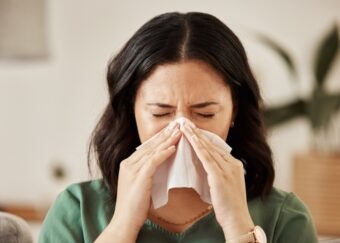What’s Causing My Headache?
Posted: August 4, 2025 | By: Shanon Peckham

Headaches and migraines are the worst. They range from the mild, but annoying everyday headache all the way to the completely disabling migraine attack. If you’re one of the one in six Americans who deals with more severe headaches or migraines regularly, you know how uncomfortable, frustrating, and disruptive they can be.1 Worse yet, chronic headache disorder (affecting 40% of the total world population) can take years off your life.2
So what even causes headaches and migraine attacks? The answer is: it depends.
The scientific community is still researching this topic, but so far, we know they can be influenced by genetic, lifestyle, environment, health, and other factors.3 There are reportedly as many as 150 types of headaches, making it potentially challenging to nail down the cause of your headaches.4 If you want to get to the bottom of the migraine mystery, we recommend talking to your doctor, tracking your symptoms, and exploring various triggers.
To give you a head start, we went ahead and put together a list of everyday headache and migraine triggers to avoid – plus practical, holistic-friendly relief solutions!
MalNutrition & Dehydration
You may not think of food when trying to suss out why your temples are throbbing, but your nutrient intake (or lack of it) can play a part. Poor diet and nutritional deficiencies can generate all kinds of unpleasant symptoms like fatigue, muscle weakness/cramping, brain fog – and yes, headaches. According to the National Headache Institute, deficiency in key vitamins like B vitamins, Vitamin E, and Vitamin D can cause headaches.5,6,7 Skipping meals/fasting too long or not giving your body enough water can also lead to painful “hunger headaches” and “dehydration headaches”, respectively.8,9 Lastly, the experts recommend avoiding alcohol, chocolate, nitrates or MSG, aged cheeses, processed or cured foods, and fermented or pickled foods, which may trigger or worsen migraine symptoms.3,10,11
Curious about intermittent fasting? Our YFast program can help you make the most of fasting while ensuring adequate foundational nutrition – visit Youngevity.com to learn more.
RELATED: How to Support GLP-1 and Weight Loss with Nutrition
Poor Air Quality
Considering 46% of Americans live in places with unsafe levels of air pollution and nearly a third suffer from seasonal allergies every year, this category is a big one for headache prevention.12,13 Poor air quality and seasonal allergies can cause inflammation and even damage our sinuses, leading to breathing difficulties, headaches, and more.14,15 Smoke, pet dandruff, dust, emissions, spores, pollen, and chemicals may be unavoidable where you live and work, but thankfully, high-quality air purifiers, essential oil diffusers, and saline solution/sinus rinses can provide medication-free relief.16 You can also check the U.S. Air Quality Index (AQI),17 weather report, and news in your local area to plan around these triggers.
Sleep Deprivation
Poor quality rest can cause headaches, among other negative health impacts.4 Unfortunately, both oversleeping and under sleeping can trigger head pain. So can teeth grinding and apnea, which happen uncontrollably in our sleep.18,19 Chronic migraines also contribute to poorer sleep, creating a vicious cycle that may be difficult to break.18 The best thing you can do to help prevent sleep-related headaches is to build a consistent sleep routine and a lifestyle that supports better sleep.
RELATED: Build a Better Sleep Routine in 5 Easy Steps
Stress & Muscle Tension
With over 100 different types of headaches, there are plenty more causes of headaches to be aware of in your better health journey. Chronic stress is a big one; the American Psychological Association estimates nearly 40% of Americans suffer from stress-related headaches.20 It’s also a trigger for the majority of those who deal with migraines specifically.21 Tension headaches, one of the most common types of headache, can be aggravated by stress, as well as bad posture, muscle tension, and eye strain22,23 – issues that come up for most of us at work. For soothing tension headaches, we recommend a dark, quiet room, extra water, and a cold/hot compress to get you through the worst of it. Next, commit to frequent stretch breaks/walks, try a standing desk or extra lumbar support, invest in some reading glasses, and find ways to address your daily stress.
Underlying Causes
In a lot of cases, the triggers we listed above may not apply and a deeper dive is required (ideally, with a doctor, specialist, or other certified care provider). Other less-talked-about but common causes of headaches/migraines are hormonal changes/menstruation, flickering lights/light sensitivity, and intense coughing.4,24,25 Genetic disorders, chronic illness, medication complications/interactions, supplement dosage issues, and other underlying health conditions also play a big role.4 The best thing you can do in this case, especially if you’re experiencing frequent or intense pain that won’t subside, is to immediately seek guidance from a medical professional, start tracking your symptoms, and mitigate your exposure to known triggers where possible.
We hope this information gets you one step closer to resolving the cause of your headaches/migraines so you can get back to pursuing your goals and enjoying life to its fullest!
Sources
2 Migraine and other headache disorders, World Health Organization
3 Migraine Headaches, Cleveland Clinic
5 What Vitamin Deficiencies Can Cause Headaches?, National Headache Institute
6 Vitamin deficiency anemia, Mayo Clinic
7 The Role of Vitamin D in Primary Headache–from Potential Mechanism to Treatment, 2020
8 Hunger Headache, Cleveland Clinic
9 Dehydration Headache, Cleveland Clinic
10 Diet and Headache Control, American Migraine Foundation
11 Foods That Trigger Migraine (and Alternatives), Healthline
12 State of the Air, Key Findings, American Lung Association
13 Allergy Facts and Figures, Asthma and Allergy Foundation of America
14 Air Quality and Health, Johns Hopkins Medicine
15 Allergy Headaches, American College of Allergy Asthma and Immunology
16 Seasonal allergies: Nip them in the bud, Mayo Clinic
17 Air Quality Index (AQI) Basics, AirNow.gov
18 How Sleep Disorders Interact with Headache and Migraine, American Migraine Foundation
19 Sleep Apnea Headaches, Sleep Foundation
20 Stress in America 2022, American Psychological Association
21 Stress and Migraine, American Migraine Foundation
22 Tension-Type Headache: Symptoms, Types and Treatments, American Migraine Foundation
23 Tension Headaches, Mayo Clinic
24 Menstrual Migraines (Hormone Headaches), Cleveland Clinic
Posted in:






